Paludariums are the new kid on the block.
A creation for those who can’t choose between the terrarium and aquarium hobbies (and then decided they’ll have their cake and eat it too).
As a modern fusion of terrestrial and aquatic elements, paludariums have the potential for some seriously stunning scenes. But, as you might imagine, they also come with their own challenges and nuances.
You thought managing water levels in a closed tropical terrarium was tough? Wait till you add waterfalls…
In this guide, we’re going to run through all the important elements of a paludarium tank, from construction to plants, animals, and care.
Here we go!
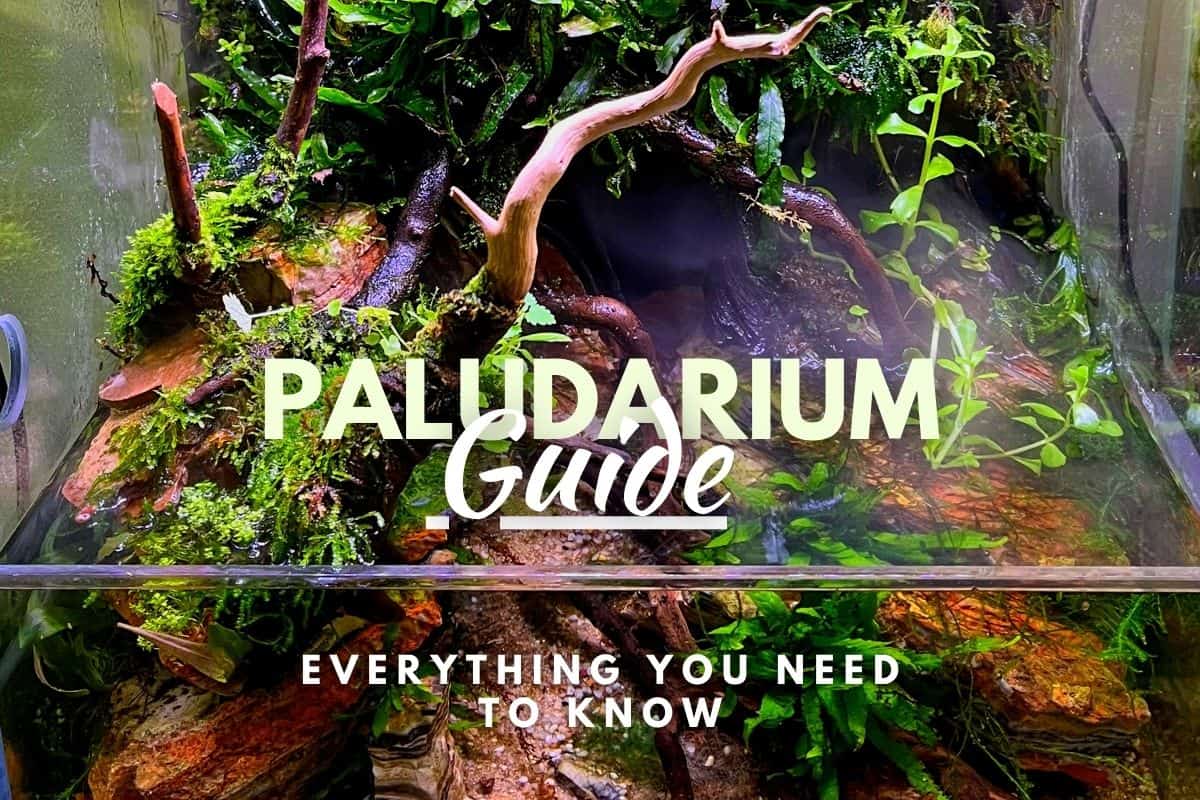
Terrarium Tribe is reader-supported. When you purchase through links on our site, we may earn an affiliate commission (at no further cost to you). 💜
What is a Paludarium?
A paludarium is a unique type of vivarium that can accommodate both terrestrial and aquatic elements in the same tank.
This versatile wonder can take many forms, from vast mountainous creeks to gentle low-land pools. Or, how about a dark and brooding mangrove forest?
Honestly, the degree of natural artistic variation here is enormous.
Though the true origins of the word paludarium actually come from the Latin word ‘palus‘ meaning swamp – and just to be awkward, a riverbank scene may also be called a “riparium” – there are actually no hard and fast rules here.
Honest…
👉 See my guide to the different kinds of Ariums for the full breakdown.
Probably the best thing about a paludarium is the ability to create a complete semi-aquatic biome at home. You have access to a vast array of plant species, and there’s the potential to harmoniously pair animals of various kinds together (i.e., land + water-dwelling).
So, whether you’re looking to create an ideal natural habitat for an animal friend or just want to make the most stunning planted paludarium you possibly can – read on to find out how!
Mapping Out a Paludarium for Beginners
Honestly, it definitely pays to plan out your goals for a paludarium.
The finer design details can come later, but your choice of landscape, animals, and features will influence every aspect of the build. To get you started on the right track, try to answer these four questions:
1 | What kind of natural environment do you want to replicate?
A rainforest scene, for example, would typically use a taller container filled with lots of branches, tropical vines, and epiphytes. On the other hand, a more island-style aquatic scene could utilize a regular aquarium tank and stick to semi-aquatic plant species.
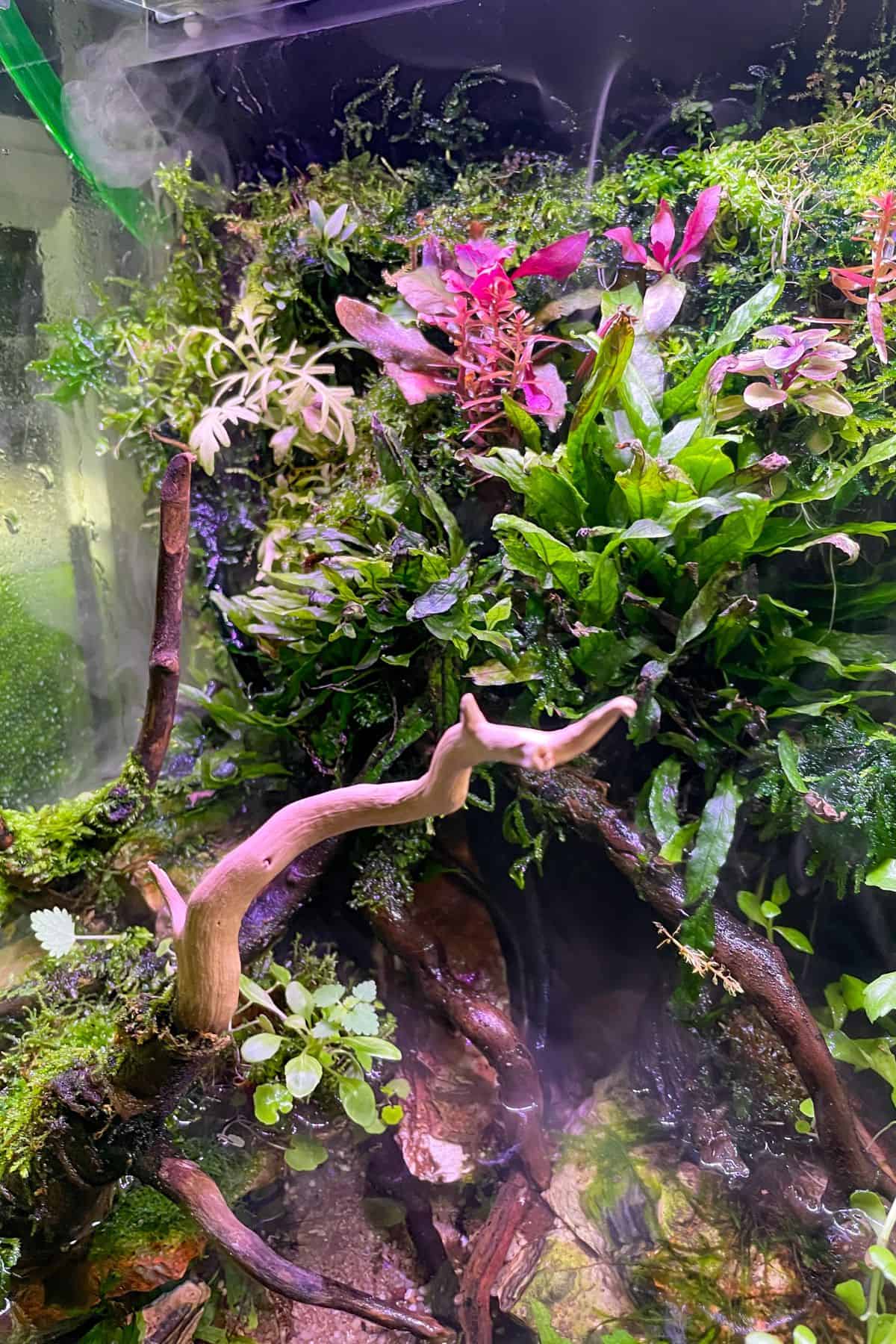
Both are fabulous choices, but they’re very different builds. So, take some inspiration from nature (or the internet) and see what appeals to you most.
2 | How much customization do you want to do yourself?
The more crafty people out there may want to use expanding foam to carve out a unique naturalistic background. Whereas I find home DIY stuff pretty daunting overall, and I don’t own any of the appropriate tools…
So, depending on your appetite for customization, you may need a variety of other materials.
Alternatively, beginners may want to opt for a simpler or ready-made solution.
3 | Which animal(s) would you like to add, if any?
Of course, adding animals into the mix is a great way to literally bring it to life, but remember, you’ll have to account for their individual needs, too. Which could mean a lot of extra hardware, complexity, and care.
4 | Would you like any extra features?
Waterfalls are a common (and super cool) addition to paludariums. These will require a little more tubing and hardware to set up, but also extra planning in how to place (and hide) said tubing in the hardscape.
With these things in mind, you should have a rough idea of the kind of project you’d like to undertake.
So now, you should be able to pick what you’ll need from the next section.
Paludarium Supplies – What Do You Need?
As you might imagine, a fusion of a terrarium and an aquarium likely has a lot of stuff going on.
Exactly what you need will depend on the complexity of your chosen project. Still, these are the paludarium supplies you’ll definitely be needing for any potential build.
Choosing a Paludarium Tank
Your choice of paludarium tank will largely dictate the kinds of scenes and animals you can use.
So choose wisely (no pressure).
They’re typically taller than most – as you need to have the depth to accommodate both a pool of water and a raised area of land – but you can adjust your design as necessary.
As much as I love to up-cycle containers, you’re best off buying a proper glass tank here.
You need to be certain that your container is watertight (at the very least) and capable of accommodating a build of this scale and complexity.
I love the elegant simplicity of the UNS Rimless Paludarium (seen below).
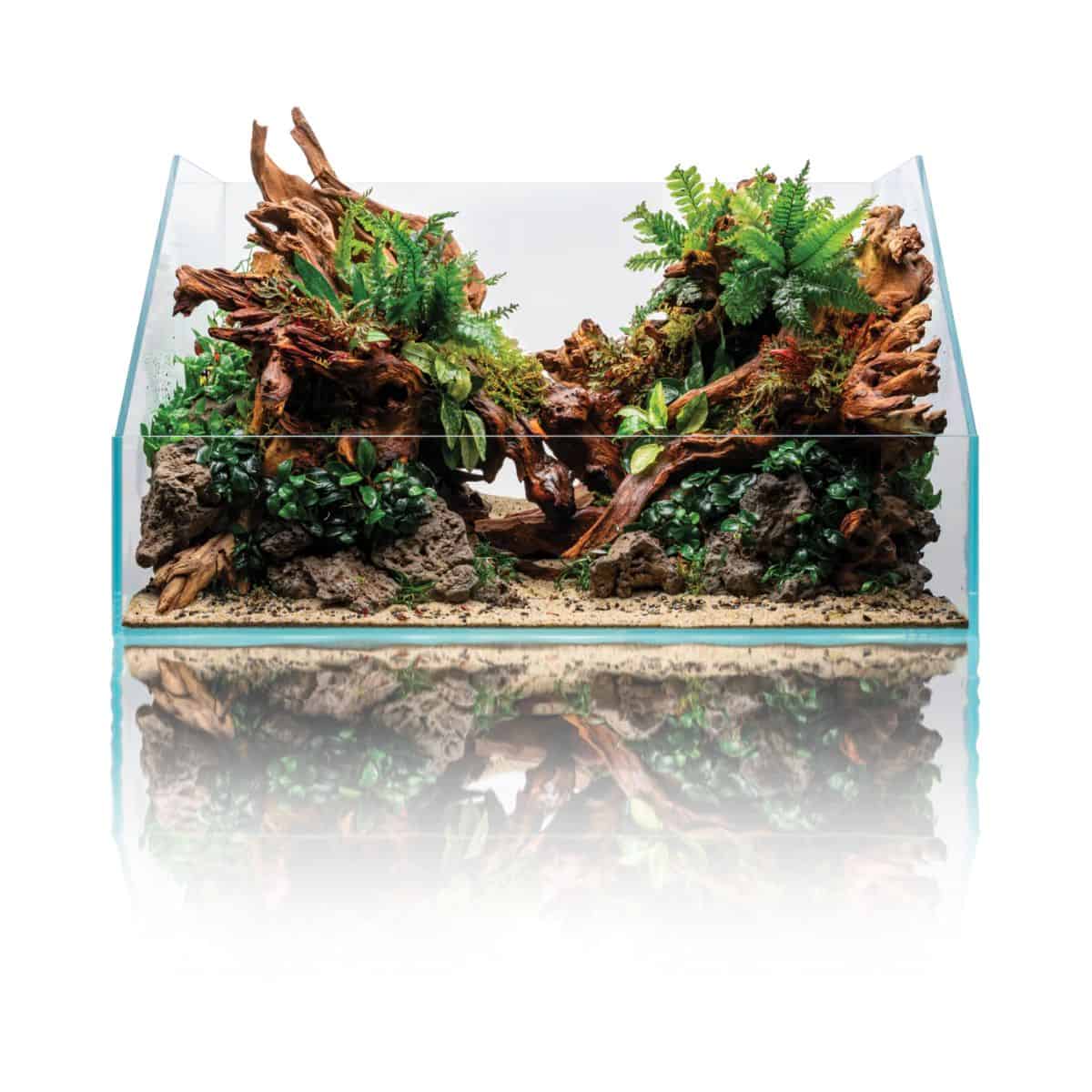

Alternatively, you can adapt either a vertical cabinet-style vivarium or a horizontal aquarium tank to your needs.
Paludarium Substrate / Soil Options
I see a few ways to approach choosing a paludarium substrate.
Generally, it’s going to depend on how much you want to utilize the water section in terms of plant life.
Suppose you’re building a rainforest biome and just want to use the water section as an empty pool for your amphibians to chill out. In that case, you really only need to focus on substrate for the “land” section. Right?
Whereas if you’re looking to fully plant up your water area to create an underwater Atlantis fantasy, you’ll need an appropriate substrate for that, too.
So, here are your options:
1. Use a typical tropical terrarium substrate blend for the “land” section (e.g., ABG soil mix or our Signature Terrarium Mix) and keep that completely separate from the water. Then, either use aquatic soil in the water or forego substrate there altogether. This will be the most likely setup for a land-focused build in a tall tank.
2. Use aquatic soil throughout the entire build. Then, utilize hardscape and substrate sculpting techniques to create high points out of the water that can function as land (like this stunning build from Green Aqua). This is more suitable for an aquascape version of a paludarium in a horizontal tank.
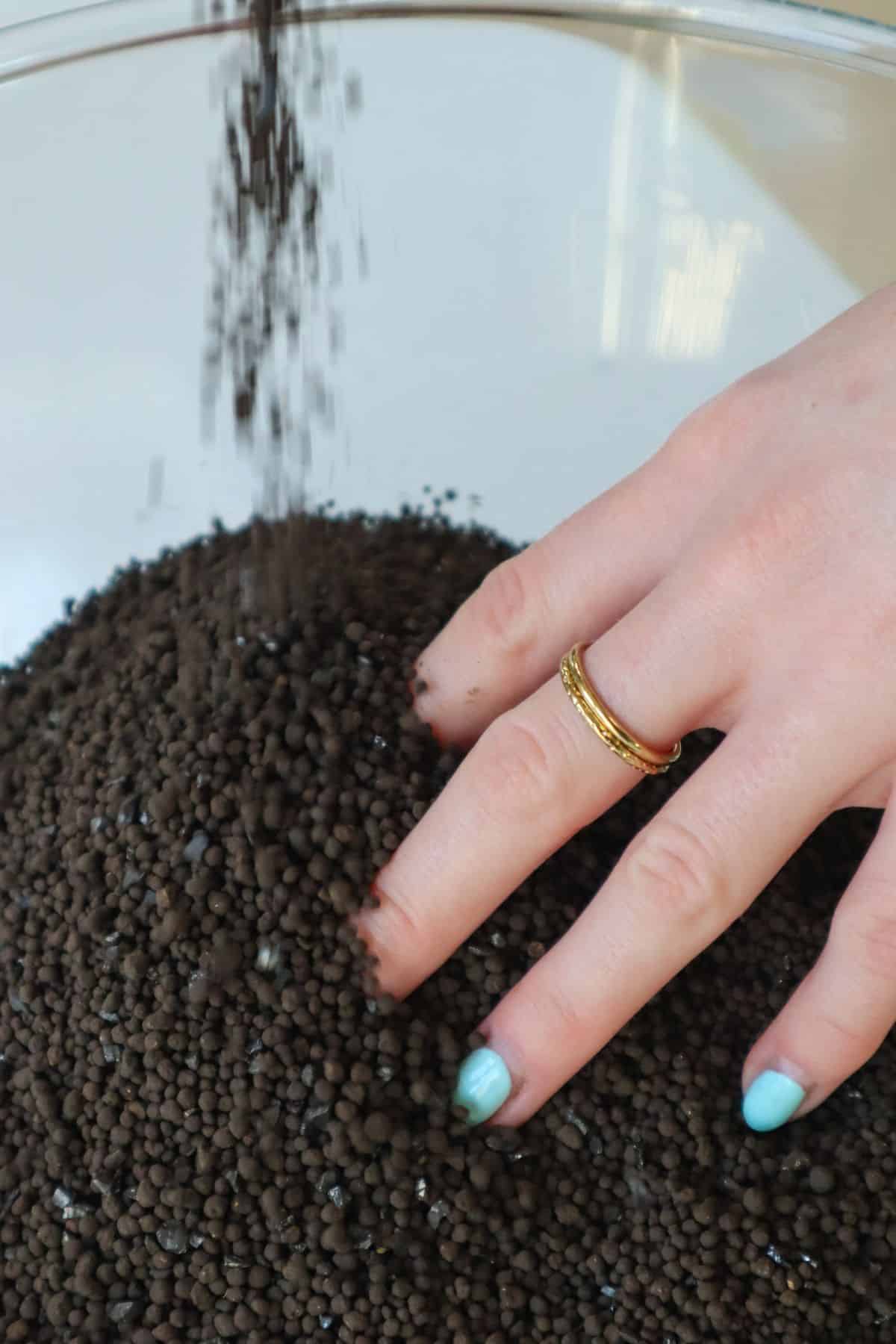
I’ve used Fluval Stratum before in a variety of terrarium builds, and I think these baked soil pellets are a fantastic all-in-one solution.
Honestly, the first option is by far the most common (and the one I’ll generally be advising on in this guide). Still, I like the simplicity of the second.
What do you think?
Drainage / Raised Bed
If you’re going with option one and you’re looking to create a completely separate land area away from your water area, then you’ll need a way to do this.
That’s typically where a partial drainage layer comes into play.
Essentially, creating a raised bed of waterproof materials that lifts up the land – out of the way of the moisture. This can be done in a few ways:
- Large rocks are a classic, albeit cumbersome, method. They can easily create the desired effect (and look natural doing it), but they add a lot of weight to the tank.
- You can also run with a classic egg crate shelf. Essentially, they’re just empty waterproof structures that are lightweight and strong. They’re cheap and can be easily cut to fit the space, but you’ll have to work harder to hide them / make them look natural.
- Foam filter pads are the easiest solution. You can pop them straight in as they are, and they have the added benefit of filtering your water. Check out these foam aquarium pads (or I hear great things about Matala mats, too).
With all of the above methods, you’ll also need to cover your chosen foundation with some sort of screen divider/ fiberglass mesh to prevent your “land” from falling through the gaps.
👉 Shop terrarium substrate mesh.

If you opt not to use a drainage layer, I’d still recommend adding some sort of porous materials to the water to help promote positive bacterial growth and add a more natural look, e.g., black lava rock, sand, or gravel.
Hardscape Items
Here, we’re talking about the natural (or at least natural-looking) structural elements in the tank.
It’s mostly a mix of dynamic rocks and twisting hardwood branches that we can use to create a sense of scale and theater. They can also do a lot of good work in stabilizing the substrate and providing planting opportunities for epiphytes.
Helpful right?
So, whilst they’re not essential, I’d highly recommend finding hardscape items that you like the look of. Having a range of sizes and shapes to hand always helps when you want to experiment.
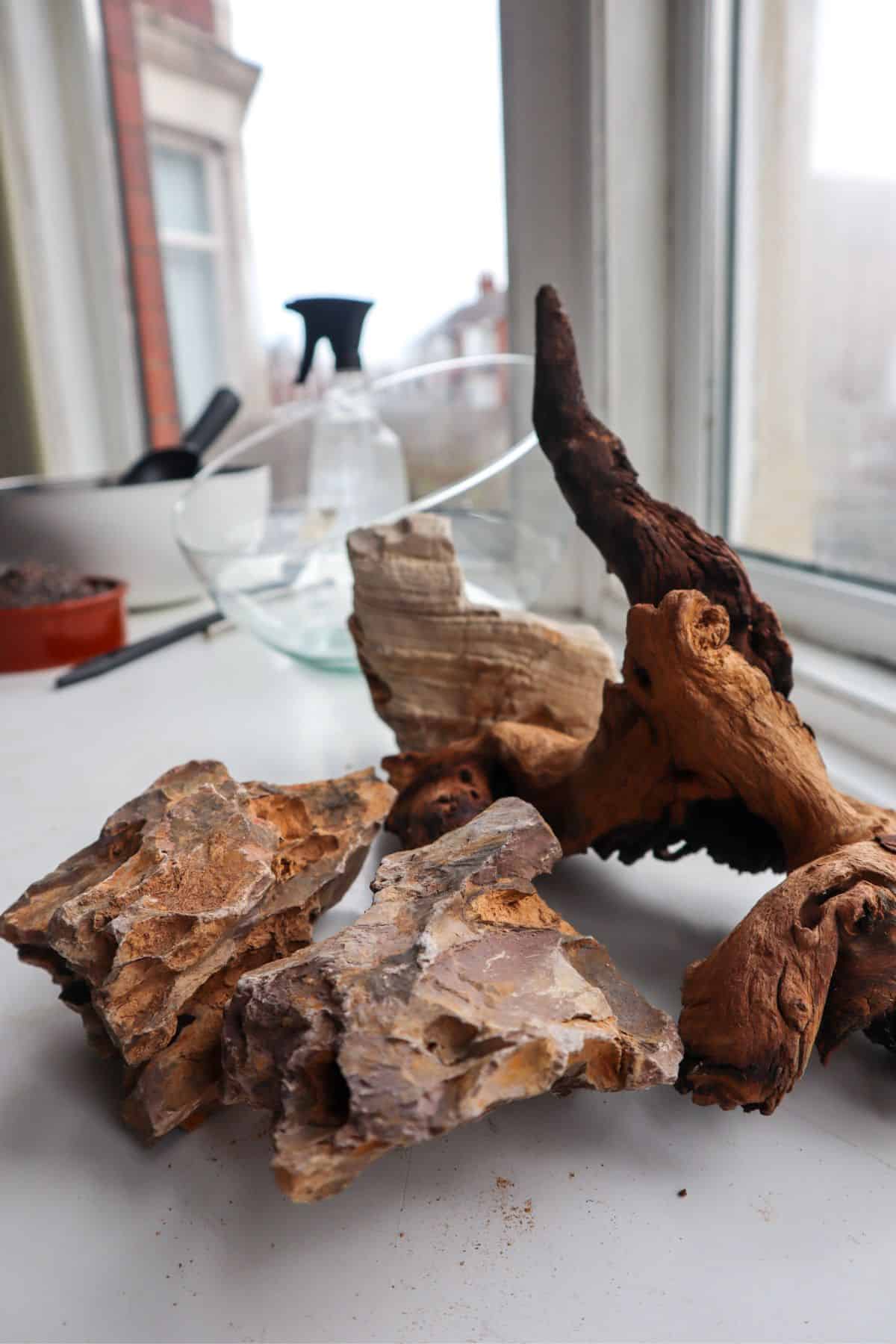
For rocks, my personal favorites are dragon stone and seiryu stone. Whereas for driftwood, mopani wood is king for me. Though, cork bark also makes an excellent choice in a variety of settings.
👉 Shop cork bark on the Terrarium Tribe store.

👉 Shop more hardscape options over at Buceplant.
Hardware Additions
Now, we’re on to the technical parts.
This section is the most variable, as it largely depends on how many features you want or what your chosen animals might need.
Due to the size and relative complexity of a paludarium build, most are going to include some form of watering system and a UV lighting setup at a minimum. It’s generally too much to manage through natural or passive means.
- Lighting – Tall terrarium containers can often get a fitted UV lighting hood to fit snuggly over the top. Whereas aquarium containers would do better with a typical aquarium strip light.
- Watering – You can use a misting system or fogging system to automatically add moisture in an even fashion, or you can get super clever with some fancy waterfall system. You do you.
Plus, mechanical filtration systems are common if you’re keeping fish or other aquatic animals. Then, terrestrial animals may need the likes of heating mats and lamps too.
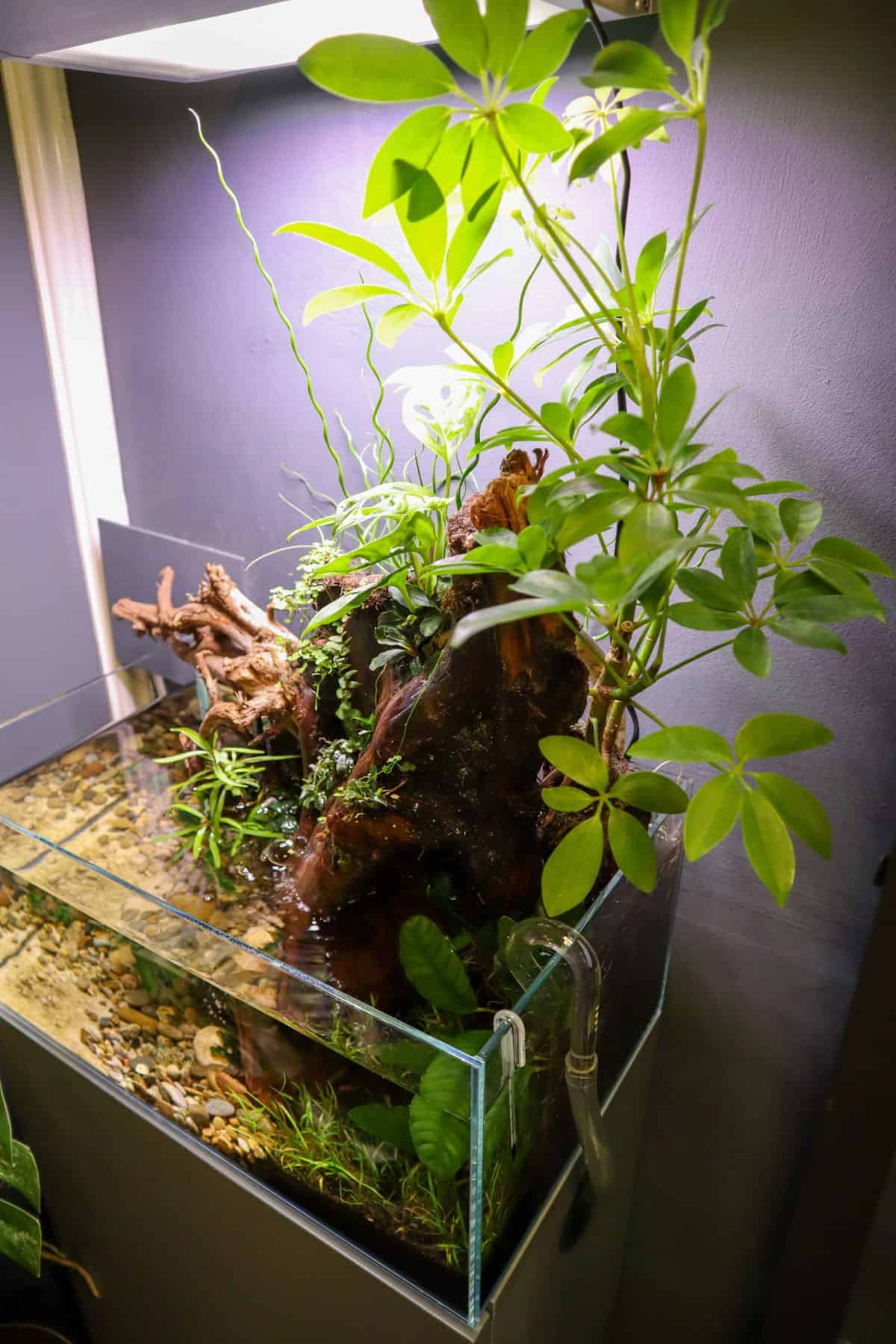
What I’m saying is that you really need to figure out your system ahead of time…
How to Choose Your Paludarium Plants
Choosing paludarium plants is a really fun process.
You have the entire spectrum of plant life at your disposal, from aquatic and semi-aquatic to terrestrial and epiphytic plants (or even some carnivorous plants).
With such a wide array of plants on offer, here’s some useful guidance to help you filter down your choices.
Semi-Aquatic Plants – This versatile category of plants can thrive in and out of the water, giving you plenty of planting options. The likes of Anubias, Bucephalandra, and Cryptocoryne species can all be used to great effect throughout the water column, near the waterline, and attached to rocks and wood in the open air.
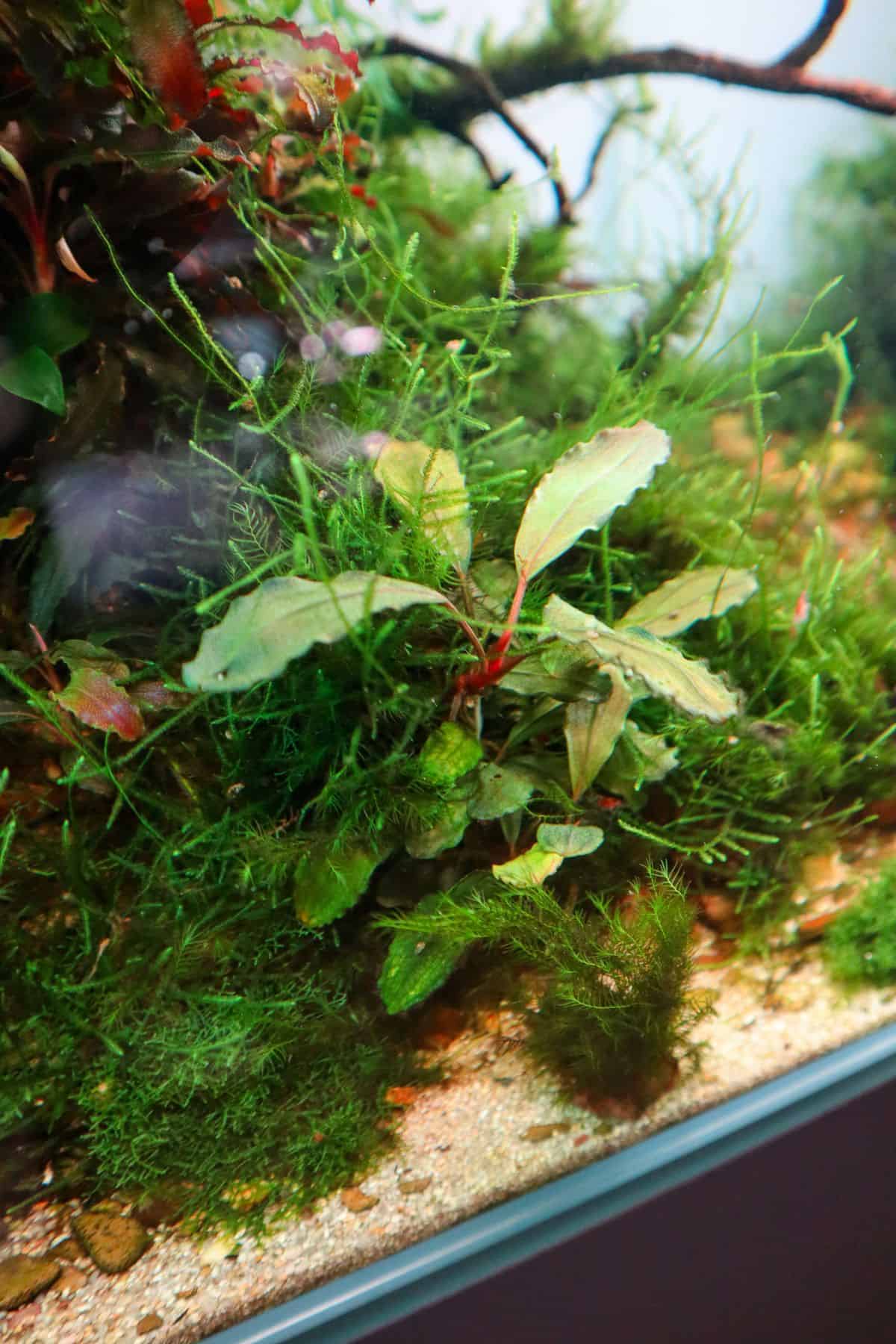
Terrestrial Plants – In line with our semi-aquatic environment, we’re best off choosing terrestrial species that thrive in high moisture. Ferns are always a winner, and there’s a huge variety of tropical vines (e.g., Monstera, Philodendron, and Pothos) and foliage plants (e.g., Fittonia and Begonia) on offer.
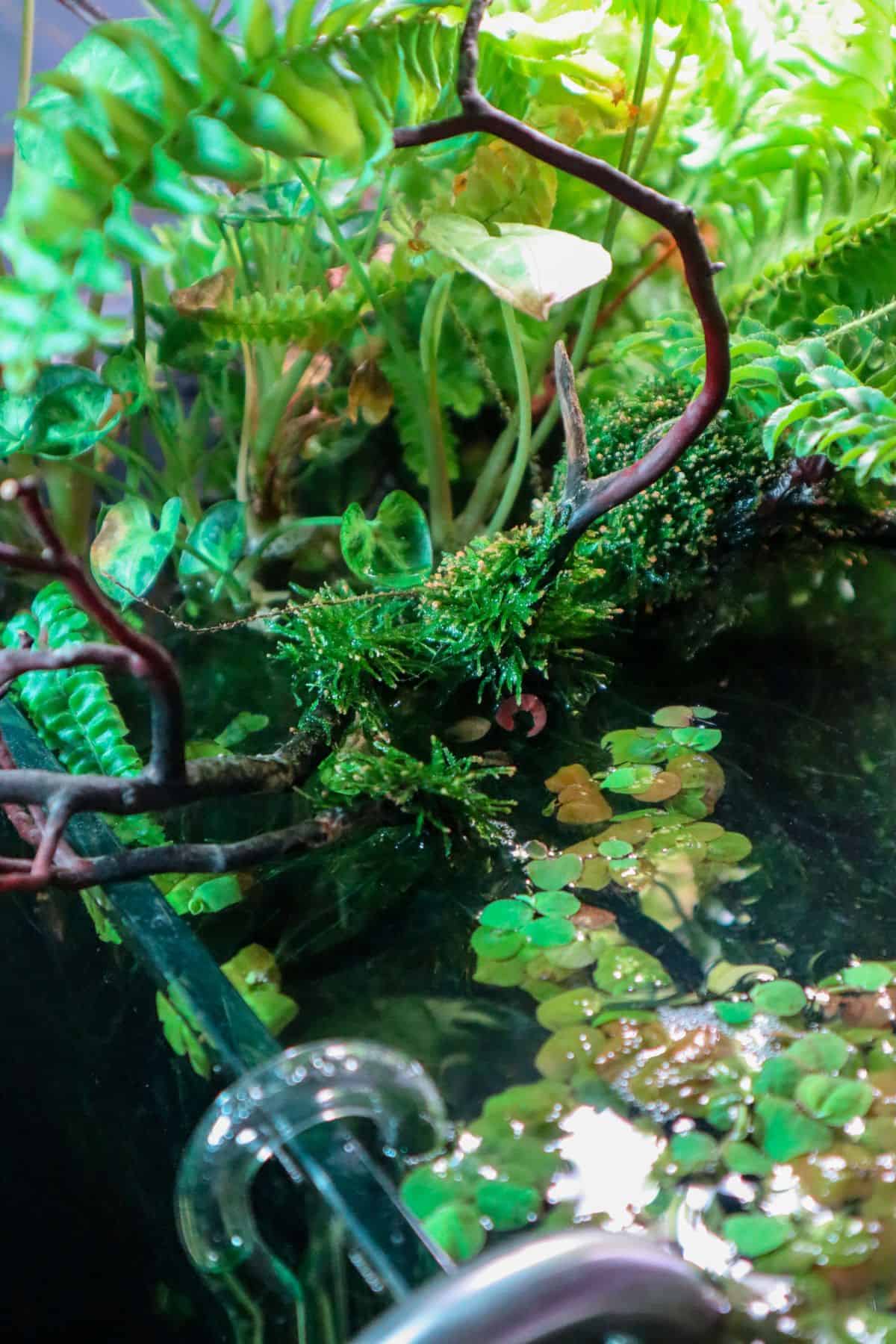
Aquatic Plants – Running with some purely aquatic plants can help diversify your options. These are most likely going to be your floating plants. You know, something to majestically swirl around the pool as you gaze upon your serene creation?
Epiphytic Plants – Finally, the icing on this wet/dry cake are the epiphytes (plants that can grow on other objects). Adding these to your hardscape can bring the upper portions of the paludarium to life. Check out the Tillandsia air plants or those from the Bromeliad genus for a colorful rainforest vibe.
👉 For a deeper breakdown (and lots more plant examples), see my Paludarium Plants guide.
Okay, now that we’ve got the plants down, how about the animals?
Options for Paludarium Animals
Naturally, there are a wide variety of potential paludarium inhabitants.
From frogs to fish and shrimp to snakes – this modern environmental fusion can support all kinds of life if you do it right. Finally, there’s a way to create a complete natural biotype in a container.
But, you really do have to be careful how you go about it.
After all, multi-species vivariums are not typically recommended due to the numerous challenges associated with keeping them all happy.
What makes a paludarium different?
Well, with two distinctly different habitats (in and out of water), you can have two different kinds of animals that may never directly interact. I doubt your tree frog will ever have beef with a random fish in the water…
That being said, I still think you’re best off sticking to one type per area (e.g., fish + frog or shrimp + lizard) unless you really know what you’re doing.
Types of Paludarium Animals
The easiest place to start? It’s got to be fish.
There are all kinds of small freshwater fish that would thrive in a paludarium setting. Guppies and Mollies seem to be popular options, but there really are lots to choose from.
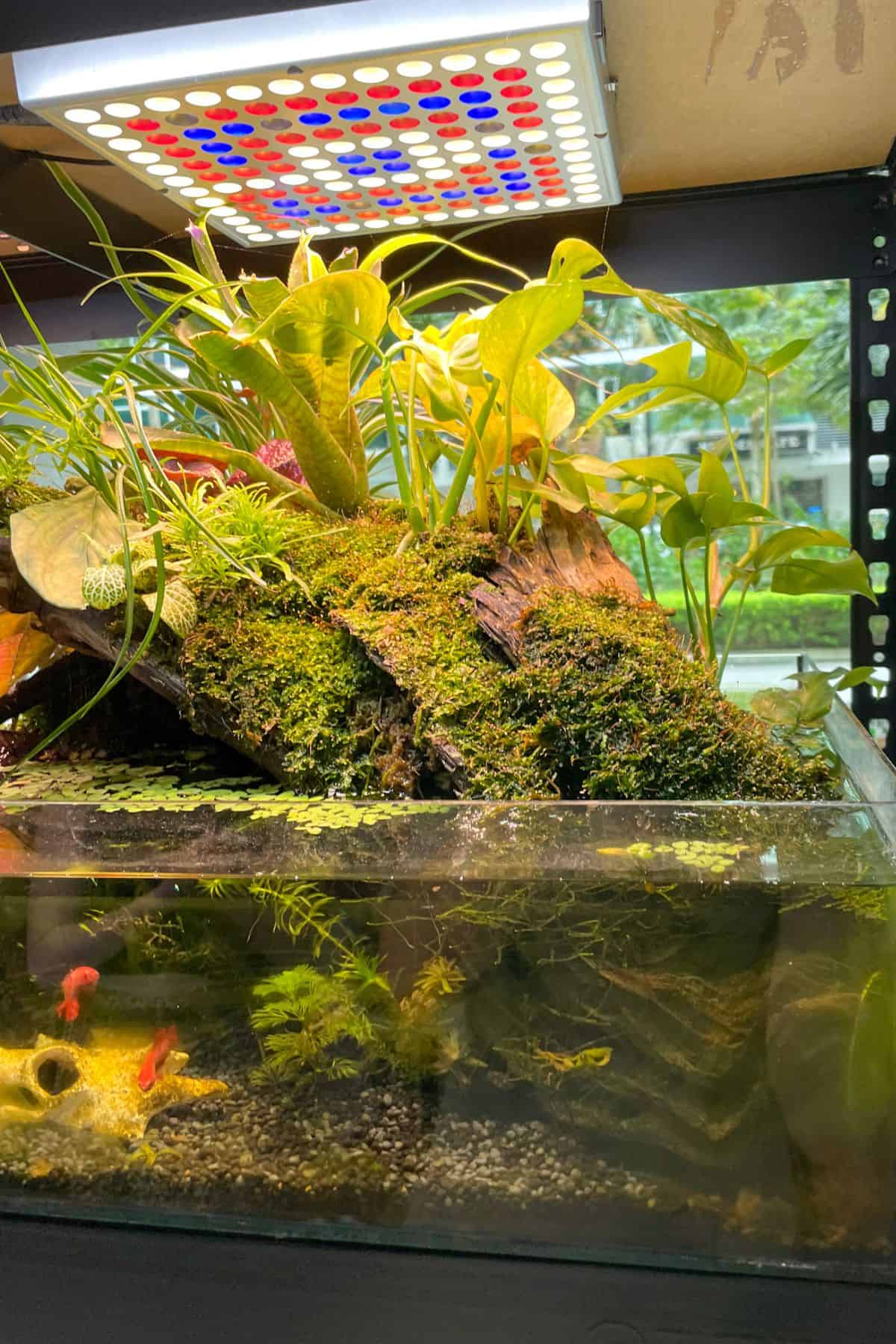
Shrimp and snails are easy to keep, too, and have the added benefit of cleaning your tank!
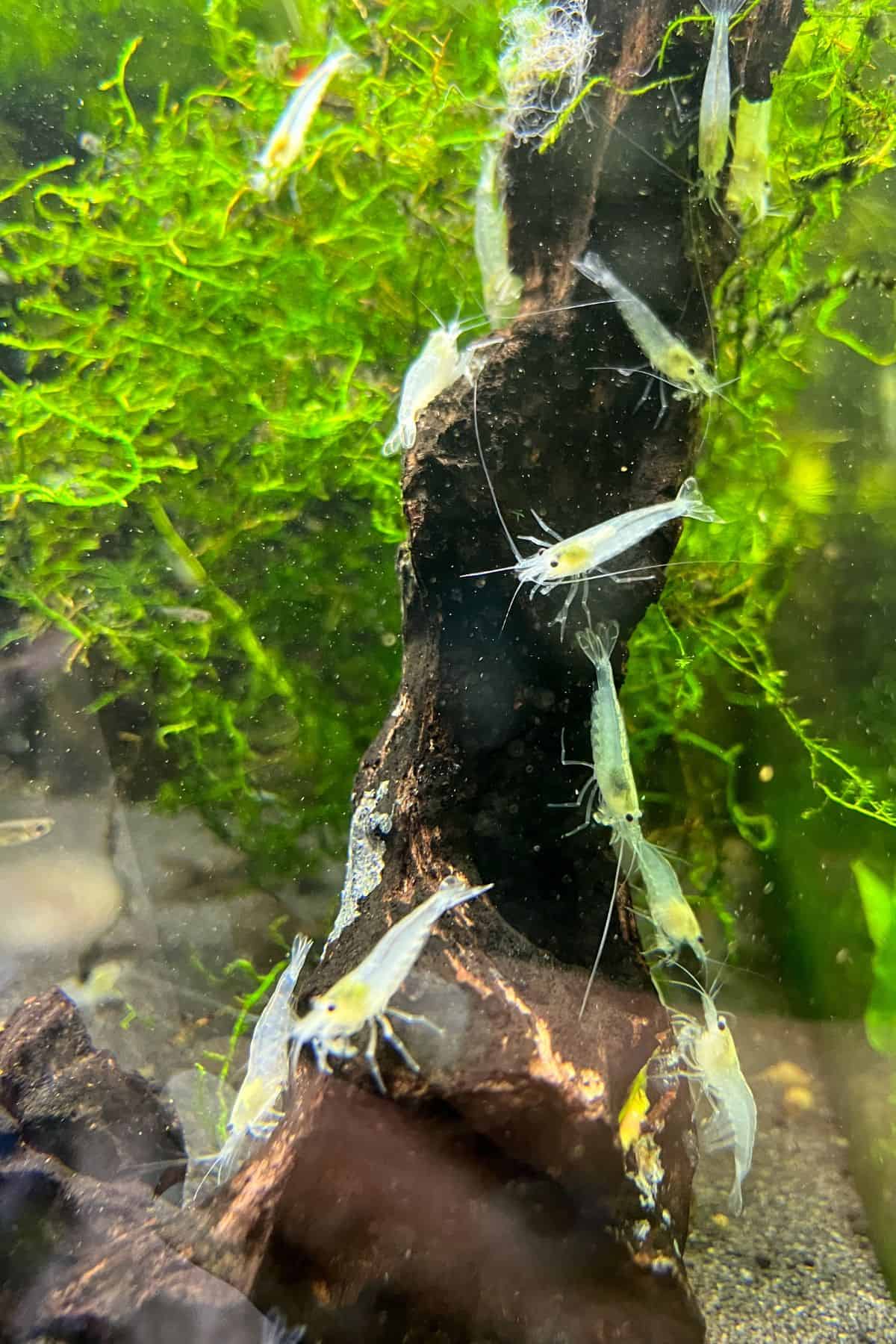
Next up, the amphibians.
Frogs and toads can be great starter pets, and they’re going to thrive in the humid atmosphere of a paludarium. Or, you can go for the more exotic newts and salamanders for something different.
For larger tanks with more land space, lizards and other reptiles become available. Plus, taller tanks with lots of climbing opportunities lend themselves to arboreal species like snakes and lizards (e.g., Chinese Water Dragons).
Ultimately, the best paludarium animals are always the ones you can keep the best. Their health and happiness should always be the priority.
Bioactive Additions
No paludarium tank would be complete without the bioactive cleanup crew!
Isopods and springtails are the perfect way to keep your tank clean without getting your hands dirty. I recommend them for every build.
They’ll feed on mold or decaying organic matter, take care of any animal waste in the process, and nourish the substrate.
If your goal is to have a self-sustaining paludarium ecosystem, these bioactive additions are a must.
👉 Grab a springtails culture here and check out our range of isopods for terrariums on our online store (look for the purple “Cleanup Crew” badge).
However, just bear in mind that some of the larger animals may use your cleanup crew as a snack. Which is usually fine; you just need more of them.
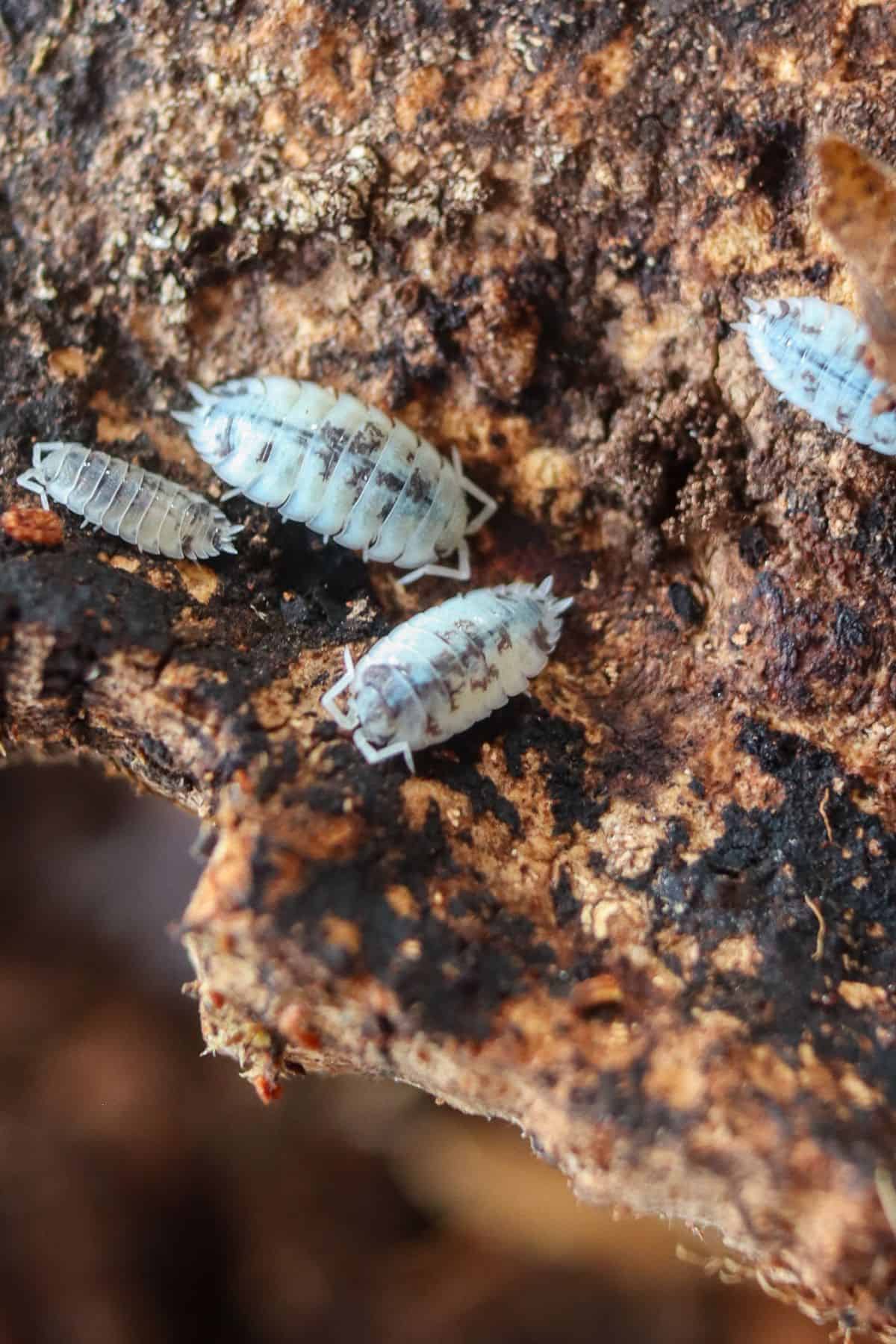
How to Build a Paludarium – Step-by-Step
Every build is truly unique, and the scope for paludarium ideas is seemingly limitless.
However, the basic paludarium construction process is pretty consistent across the board.
Split into three key layers: the water, the land, and the plant canopy. Much like building a house (albeit a very wet one), a tank is built up in stages – starting from the bottom.
- 1 | Lay the foundation – Start by adding your drainage layer to the bottom of the tank. Then, add any critical hardware involved in the water system, i.e., any necessary filter plumbing, pumps, etc. That way, you get a good idea of where you’re going to position everything and can build up around it.
- 2 | Create your structure – Next, you’ll want to add any of your large hardscape items to the tank. The big rocks and core driftwood branches will shape the structure of your landscape (and ideally hide your hardware). You can also use expanding foam to seal up areas and create new structures.
- 3 | Add your soil – With the foundation in place, it’s time to make your land section. Add your chosen substrate and sculpt it to create a natural-looking landscape with enough depth to plant in.
- 4 | Test the system – Now is a good time to fill your tank with (ideally distilled) water and make sure everything stays in place! Once you’ve filled your tank, connect up your hardware systems, like your filters and heaters, and give it a good test run to make sure everything runs smoothly. *Also, if you’re adding animals to your water area, then you must cycle it appropriately first.
- 5 | Planting and decorating – Once you’ve confirmed your paludarium setup is safe and working, now comes the fun part. Starting from the bottom up, you can start bringing your creation to life. Plant your immersed species, working up to your terrestrial plants and tropical vines. Finally, add your epiphytes and pull it all together with moss.
- 6 | Make it bioactive – Now that your habitat is complete, the inhabitants are free to move in. First comes the bioactive cleanup crew, as they’ll need to settle in and start driving those nutrient cycles. Then, you’re free to add whichever animals you wish.
Over to You
Phew, that’s a long one!
If you’ve made it this far, then you’re well on your way to DIY paludarium success.
What kind of landscape are you planning to build?
Let me know in the comments!

Love that you added this Dan! I’ve been wanting to make one for a while now, really thinking I might take the plunge after reading this. Do you happen to have a paludarium yourself right now?
Not right now, but I’d love to in the future!
Hello. Any reason you didn’t mention LECA for the substrate?
Lots of reasons really, it can float and retain water which isn’t ideal. Aquatic soil is the better choice.
“New kid on the block,” heh, I put together my first paludarium in 1994 after reading an article on them in Tropical Fish Hobbyist magazine. This was around the time that zoos, public aquariums, and science museums were putting in indoor rainforest exhibits and it felt like having my own. I put my latest one together in January of 2020 and it was a source of sanity during lockdown.
Haha fair point, I think most of the online terrarium world is only just catching up to you Mark!
Hello! I am going to attempt a Paludarium for my Firebelly Newts! They have been terrestrial as they are babies, but they are ready for more water now! Wish me luck!
Dan, I can not believe that I found this on line. I’ve been trying to figure out how to combine an aquarium with a waterfall and land scape for months. I have built a paludarium for senior citizens, housing a gold fish and the back wall was created with foam. When I had larger aquariums they were well planted and did not require an expensive filter. Foam in the corner with a small table fountain pump was all that was needed. At this time I have a 12x12x12″ all glass tank and I want to build a paludarium/aquarium with a waterfall. I will follow any advice that you can give me. I have printed out the article and now I know now where I can purchase the necessary plants,etc,etc.